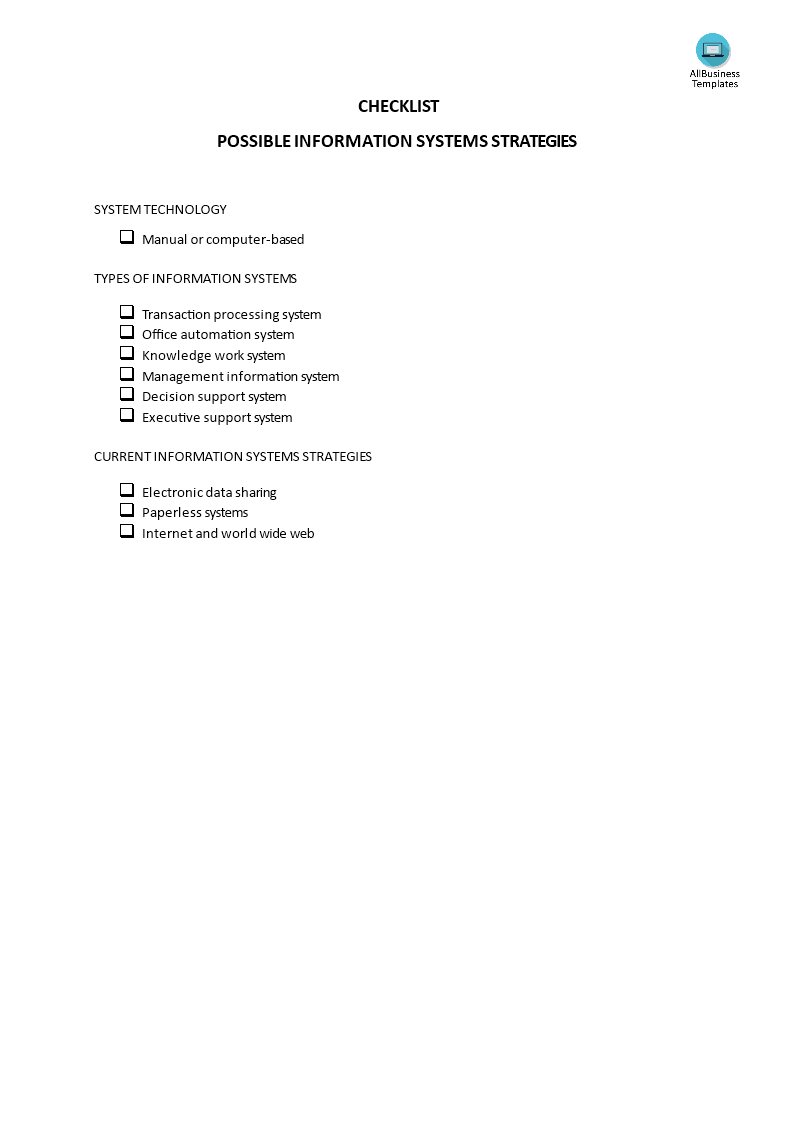Checklist Possible Information Systems Strategies
Save, fill-In The Blanks, Print, Done!

Download Checklist Possible Information Systems Strategies
Today: USD 2.99
Download It Now

Available premium file formats:
Microsoft Word (.docx)- This Document Has Been Certified by a Professional
- 100% customizable
- This is a digital download (23.61 kB)
- Language: English
- You will receive a link to download the file as soon as your payment goes through.
- We recommend downloading this file onto your computer.
Do you need a checklist for possible information systems strategies? How do you create a checklist of possible information systems strategies? We have created a checklist template with all the information you need to consider when choosing an Information Systems Strategy. It includes factors to consider such as cost, complexity, scalability, and security. Check it out and see if it might be a good fit for your organization.
A checklist for possible information systems (IS) strategies is a tool used by organizations to systematically consider various approaches and options for managing their information technology and systems. Information systems strategies are essential for aligning technology investments with business goals, enhancing efficiency, and ensuring that IT resources are used effectively.
Here is a checklist of possible IS strategies that an organization may consider:
- Business Goals Alignment:
- Ensure that IS strategies align with the overall business objectives and priorities.
- Digital Transformation:
- Evaluate the potential for digital transformation initiatives to improve processes and customer experiences.
- Data Management:
- Develop strategies for effective data collection, storage, analysis, and utilization.
- Cybersecurity:
- Implement cybersecurity strategies to protect against data breaches and cyber threats.
- Cloud Computing Adoption:
- Consider cloud adoption strategies for scalability, cost-effectiveness, and flexibility.
- Infrastructure Modernization:
- Assess the need to modernize IT infrastructure, including hardware and software upgrades.
- IT Governance:
- Establish governance structures and processes to ensure IT decisions align with business goals.
- Enterprise Resource Planning (ERP):
- Evaluate the implementation or upgrade of ERP systems to streamline operations.
- Customer Relationship Management (CRM):
- Implement CRM strategies to improve customer interactions and relationships.
- Data Analytics and Business Intelligence:
- Develop strategies for leveraging data analytics and business intelligence for informed decision-making.
- Mobile and Remote Work Solutions:
- Consider solutions that support mobile and remote work for employees and customers.
- E-commerce and Online Presence:
- Explore e-commerce strategies to expand online sales and customer reach.
- Supply Chain Management:
- Optimize supply chain processes through IS strategies to improve efficiency and reduce costs.
- Artificial Intelligence (AI) and Machine Learning:
- Assess the potential for AI and machine learning applications to enhance operations and customer experiences.
- IT Talent and Skills Development:
- Develop strategies for recruiting, training, and retaining IT talent.
- Budget and Resource Allocation:
- Allocate resources and budget effectively to support IS strategies.
- Risk Management:
- Identify and mitigate risks associated with IS initiatives.
- Compliance and Regulatory Considerations:
- Ensure that IS strategies adhere to industry regulations and compliance standards.
- Vendor and Technology Partnerships:
- Explore partnerships with technology vendors and service providers.
- Disaster Recovery and Business Continuity:
- Develop plans and strategies to ensure business continuity in the event of disruptions.
- Sustainability and Green IT:
- Consider environmentally friendly IT strategies and practices.
- User Training and Support:
- Plan for user training and support to maximize the effectiveness of IS solutions.
- Feedback and Evaluation:
- Establish mechanisms for gathering feedback and regularly evaluating the success of IS strategies.
- Scalability and Flexibility:
- Ensure that IS solutions can scale and adapt to changing business needs.
- Integration and Interoperability:
- Plan for the integration of different IS systems and applications.
- Legacy System Management:
- Develop strategies for managing and potentially phasing out legacy systems.
- Innovation:
- Encourage innovation and experimentation in IS to drive competitive advantage.
- User Experience (UX) Design:
- Focus on improving the usability and user experience of IS solutions.
- Cloud Strategy:
- Define the organization's approach to public, private, or hybrid cloud solutions.
- Vendor Management:
- Establish vendor management strategies for negotiating contracts and ensuring service quality.
This checklist serves as a starting point for organizations to assess their IS strategies and identify areas for improvement or investment. The specific strategies chosen will depend on an organization's industry, size, goals, and current IT landscape.
Download this professional Checklist for a suitable Information Systems template now!
For more business templates? Just browse through our database and website! You will have instant access to thousands of free and premium business templates, legal agreements, documents, forms, letters, reports, plans, resumes, etc., which are all used by professionals in your industry. All business templates are ready-made, easy to find, wisely structured, and intuitive.
DISCLAIMER
Nothing on this site shall be considered legal advice and no attorney-client relationship is established.
Leave a Reply. If you have any questions or remarks, feel free to post them below.
Related templates
Latest templates
Latest topics
- Excel Templates
Where do I find templates for Excel? How do I create a template in Excel? Check these editable and printable Excel Templates and download them directly! - GDPR Compliance Templates
What do you need to become GDPR compliant? Are you looking for useful GDPR document templates to make you compliant? All these compliance documents will be available to download instantly... - Google Docs Templates
How to create documents in Google Docs? We provide Google Docs compatible template and these are the reasons why it's useful to work with Google Docs... - IT Security Standards Kit
What are IT Security Standards? Check out our collection of this newly updated IT Security Kit Standard templates, including policies, controls, processes, checklists, procedures and other documents. - Letter Format
How to format a letter? Here is a brief overview of common letter formats and templates in USA and UK and get inspirited immediately!
cheese
